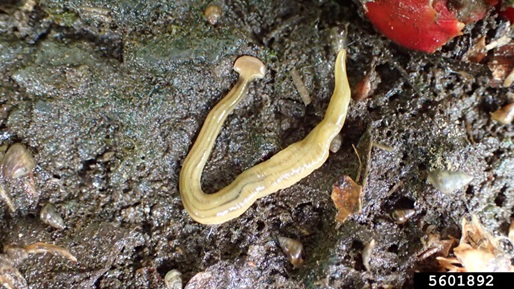Hammerhead Worms and Kentucky
ENTFACT-712: Hammerhead Worms and Kentucky | Download PDF
Jonathan L. Larson, Extension Entomologist
University of Kentucky College of Agriculture
Fast Facts
- Hammerhead worms are ribbon-like worms with hammer or moon shaped heads. In recent years, they have been a source of intrigue in the wild and on social media.
- As a group, they are predatory flatworms that feed on other slimy or wormy critter such as slugs, snails, and earthworms. Hammerhead worms also contain toxins similar to tetrodotoxins and they could be harmful if ingested.
- There are native and non-native hammerhead worms in the state of Kentucky. Despite their strange appearance and fearful poisons, they pose little hazard to people or pets and control is usually not needed. However, if they are causing an issue, applying salt to individual worms or -without touching them- getting them into a sealable plastic bag with salt or vinegar inside will destroy them.
Identification of Hammerhead Worms
Hammerhead worms can be quite long, some species regularly reach 10-12 inches. They superficially resemble earthworms. As land planarians, a type of flatworm, hammerhead worms lack the segmentation that is evident on earthworms. In addition, their sickle, hammer, and shovel-shaped heads help to differentiate them from earthworms.

Hammerhead worms range in color from honey colored to a darker brown. Some species also have dark lines that run down their backs. Two examples are Bipalium kewense or the hammerhead flatworm which has five dark lines and Bipalium pennsylvanicum or the three-lined flatworm.
Potential Issues with Hammerhead Worms
Hammerhead worms and other flatworms do play important roles in the environment as predators for things like earthworms, snails, and slugs. Unfortunately, some species (like the two previously mentioned ones) are non-native organisms which could potentially become invasive and have negative effects on Kentucky ecosystems.
For example, due to their predation on earthworms, hammerhead worms could potentially decrease their populations. Generally speaking, earthworms are considered beneficia organisms that perform needed decomposition services in the wild.
Finally, hammerhead worms inspire anxiety that they might be of medical or veterinary concern. Some species produce toxins for hunting which are like tetrodotoxins, powerful poisons that are most famously associated with pufferfish. Encountering or even accidentally making skin to worm contact won’t automatically kill you or a pet. There could be skin irritation in some cases. Hammerhead worms are also potential hosts for rat lungworms, as are snails and slugs. Humans can acquire this parasite by consuming undercooked or raw snails, slugs, freshwater shrimp, crabs, and frogs. Due to these risks, it is important to not eat hammerhead worms.

Hammerhead Worms and Kentucky
Between 2020-2022, hammerhead worm samples were confirmed from Letcher, Calloway, Pulaski, and Fayette Counties. In 2023, further confirmations were made from samples contributed from Marshall, Boyd, Casey, Pike, Graves, and Whitley Counties. This suggests a possibly wide distribution in the state.
Hammerhead worms are most likely to be found in warm, damp environments. Samples submitted to UK have come from under logs, rocks, and off the sides of buildings. Anecdotally, sightings of hammerhead worms seem to increase on rainy days, particularly if the precipitation comes after a period of dryness.
Management
People should avoid handling or holding hammerhead worms. If they are touched, it is best to wash your hands afterwards.
Usually, it is best to just ignore them. If management is deemed necessary, do not cut up the worms as doing so can result in more worms. Salting hammerhead worms, like you would a snail or slug, will destroy them. Do be cautious about not getting salt in the soil around your plants. Spritzing the hammerhead worm with vinegar or citrus oil can also kill it. If you need to isolate the treatment, you can pick up the hammerhead worm with tweezers or gloved hands and put it in a sealable bag, then apply salt or vinegar.
Kentuckians can help us keep track of these worms if they would like to email photos and a location to reportapest@uky.edu.
CAUTION! Pesticide recommendations in this publication are registered for use in Kentucky, USA ONLY! The use of some products may not be legal in your state or country. Please check with your local county agent or regulatory official before using any pesticide mentioned in this publication. Of course, ALWAYS READ AND FOLLOW LABEL DIRECTIONS FOR SAFE USE OF ANY PESTICIDE!
03/25 (Issued)
